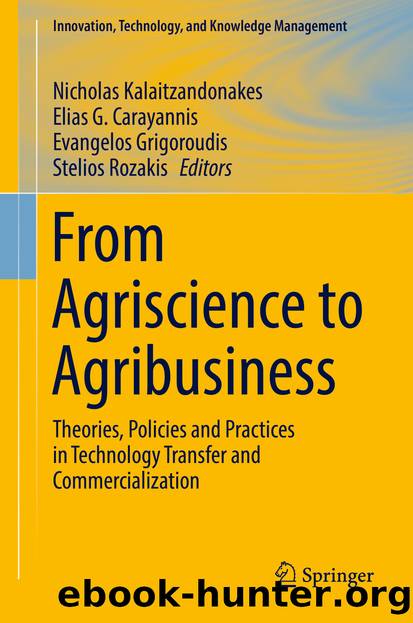From Agriscience to Agribusiness by Nicholas Kalaitzandonakes Elias G. Carayannis Evangelos Grigoroudis & Stelios Rozakis

Author:Nicholas Kalaitzandonakes, Elias G. Carayannis, Evangelos Grigoroudis & Stelios Rozakis
Language: eng
Format: epub
Publisher: Springer International Publishing, Cham
2006
6
26
12
28
28
101
2008
8
17
4
-
-
-
Avg.
9%
27%
9%
19%
43%
Source: Statistics Canada (1999, 2003, 2005, 2006, 2008, 2010)
The first thing that stands out from Table 5 is that over half of the institutes of higher education are not involved in the development of new plant varieties. Policies vary in regard to reporting, in that about 20% of institutions always require the reporting of new plant varieties, while 15% occasionally have policies of this nature and just under 10% never require the reporting of new plant varieties. Over the decade of reporting, the percentage of institutions requiring the reporting of new plant varieties varied from 25% to 35%.
Table 6 reports on the ownership structure of new plant varieties across the decade in which data was collected. Again, it is readily observable that many institutions are not engaged in agriculture research as 61% of reporting institutions either have no policy on new plant varieties or have no IP in this area. Interestingly, of those institutions reporting new plant varieties, the vast majority of the varieties are solely owned by the plant breeder that developed the variety, meaning that all of the royalties incurred through plant breeders’ rights will go directly to the plant breeder. In just 9% of cases, the institution owns the plant variety and in an equal number ownership is shared between the institution and the plant breeder.
In terms of how institutions manage IP, plant varieties are not part of research activities at many institutions of higher learning (Fig. 5). In comparing research ownership of other forms of IP, the number of institutions reporting that they have no plant varieties at their institution is double that of those institutions holding trademarks of industrial designs. Institutional policy favoring the researcher is evident as researchers retain ownership more than any other form. While copyright residing with researchers is logical based on publication practices, it is somewhat surprising that researchers own such a high percentage of IP in terms of patents and industrial designs.
Fig. 5IP ownership, 1998–2008 (Source: Statistics Canada (1999, 2003, 2005, 2006, 2008, 2010)
Download
This site does not store any files on its server. We only index and link to content provided by other sites. Please contact the content providers to delete copyright contents if any and email us, we'll remove relevant links or contents immediately.
Life 3.0: Being Human in the Age of Artificial Intelligence by Tegmark Max(5189)
The Sports Rules Book by Human Kinetics(4079)
The Age of Surveillance Capitalism by Shoshana Zuboff(3990)
ACT Math For Dummies by Zegarelli Mark(3853)
Blood, Sweat, and Pixels by Jason Schreier(3494)
Unlabel: Selling You Without Selling Out by Marc Ecko(3472)
Hidden Persuasion: 33 psychological influence techniques in advertising by Marc Andrews & Matthijs van Leeuwen & Rick van Baaren(3292)
Urban Outlaw by Magnus Walker(3243)
The Pixar Touch by David A. Price(3210)
Bad Pharma by Ben Goldacre(3098)
Project Animal Farm: An Accidental Journey into the Secret World of Farming and the Truth About Our Food by Sonia Faruqi(3018)
Brotopia by Emily Chang(2898)
Kitchen confidential by Anthony Bourdain(2831)
Slugfest by Reed Tucker(2803)
The Content Trap by Bharat Anand(2778)
The Airbnb Story by Leigh Gallagher(2702)
Coffee for One by KJ Fallon(2422)
Smuggler's Cove: Exotic Cocktails, Rum, and the Cult of Tiki by Martin Cate & Rebecca Cate(2339)
Beer is proof God loves us by Charles W. Bamforth(2251)
